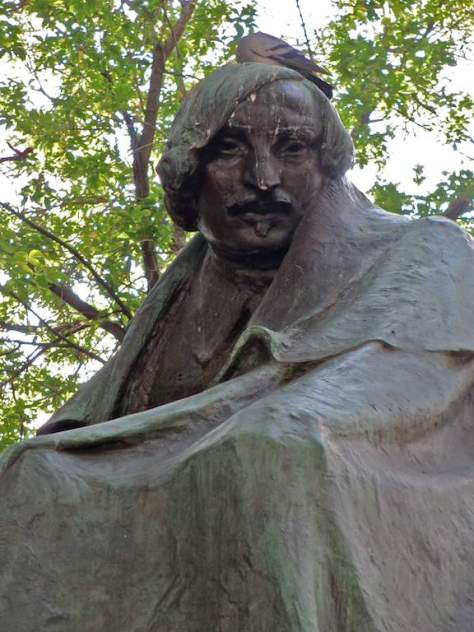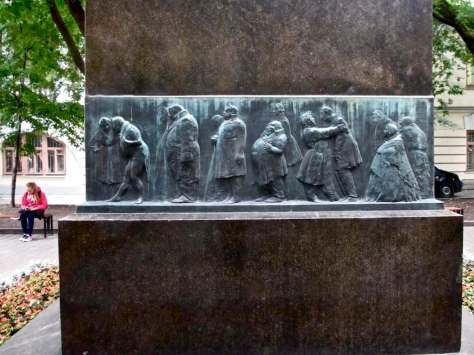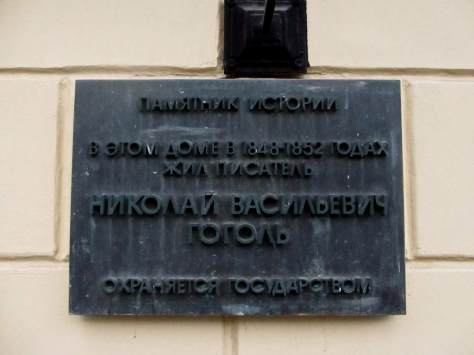This may be the finest monument to a cultural figure in Moscow. It is a major work of art in its own right and, like anything of greatness, it has had a tough time making it in the world. Sculptor Nikolai Andreev spent three years creating this moving likeness of Nikolai Gogol, which stands atop a large pedestal rung on four sides by bas reliefs of characters drawn from the writer’s works. It was finally unveiled on Prechistensky Boulevard in 1909, on the centenary of Gogol’s birth. It was intended to show the great novelist and playwright in his period of spiritual crisis toward the end of his life. Not only does it do that beautifully, it captures the essence of spiritual crisis, of alienation, of loneliness, stoic fear and blank indecision. In short, many hated it from the moment it was first unveiled. You know the drill: “Where’s the happy face?!” A poet hiding behind the pseudonym of Someone in Black, responded to the event by placing the following ridiculing verses in the Early Morning newspaper:
The cover was lowered,
The crowd was amazed,
The cantata resounded –
To Gogol give praise!
The dream was now real,
But hearts were now pained:
A face full of sorrow
A pose full of strain!
The crowd became sad,
All understood without words!
As my great friend and former handball partner at Harvard Stephen Moeller-Sally wrote in his excellent book, Gogol’s Afterlife, “…Andreev’s hunched, contemplative figure represented the final years of Gogol’s life, a period of ill health and creative decline. For this reason [people] found it unacceptable. Whatever interpretive insight Andreev’s statue may have contained, it did not fulfill the purpose of the monument: it could not serve as a symbol of national pride.” The doggerel above is also taken from Steve’s book, in his translation.
Not surprisingly, Joseph Stalin didn’t like the monument either, and he finally decided in 1952 to have it moved to a courtyard not far away where nobody would see it. He replaced it with a happy-faced, straight-backed Gogol that looked as much like Stalin himself as Gogol, and which we’ll look at and talk about at a later date. As such, the monument you see in these photos is now located out of the way in the yard before the Gogol Museum at 7A Nikitsky Boulevard.
The Gogol House, or Gogol Museum, is located in a beautiful old building that Gogol himself lived in from 1848 until his death in 1852. As such, the current placement of the work is actually ideal. It is an isolated place, quiet and shady, and people come here with books to sit by the great man’s feet, if you will, to read and contemplate. I know I shouldn’t be surprised by the shortsightedness of those first people who saw the statue in 1909, but, still, ignorance never fails to astonish me. So let me lean on Steve Moeller-Sally to point fingers at some very unsagacious folks:
“Artistic professionals were also unimpressed,” Steve writes in his book. “A number of them felt that the sculptor had not succeeded in representing Gogol at all. Some faulted Andreev for poor technique, noting that there was no sense of body underneath the mantle or that the nose was exaggerated. Others expressed their opinions more imaginatively, the artist I. Chugunova called the statue a ‘monument to an unknown old woman,’ and a noted art collector, Doctor P. Postnikov, said it gave the impression of ‘a kite or a carrion-crow with a broken right wing.’ Dissatisfaction with the monument grew so intense that a Moscow patron of the arts, I. Tsvetkov, began a new subscription for the recasting of the Gogol monument.”
To all of which I say, Pshaw! and, Bravo, Andreev!
Gosh. Big flaw. The artist exaggerated Gogol’s nose. Now, why in the world would he have done that???












